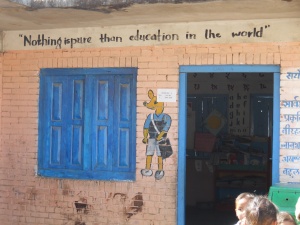A trip to Nepal would not be complete without a little mountain trekking. We strapped on our backpacks filled with a plethora of snacks and began our ascent to Mt. Everest. With a little determination, we knew we could make it to the top in time for lunch…
Just kidding. Our destination was Namobuddha, a holy site considered to be one of Buddhism’s most important pilgrimages and a symbol of human sacrifice. The bus dropped us off at 1,400 meters and the weather was perfect – cool with a slight overcast that kept the sun at bay. Even at this height, looking out at the hills and seeing thousands of terraces and villages was another breathtaking view. It’s crazy to think about the hundreds of years it took to create these self-sustainable resources that the Nepali people have used to survive day by day!
 Under the direction of our guide, we weaved on and off various dirt paths, rocky roads and even some backyards. During one of our shortcuts through a backyard, many of us stopped to watch a group of Nepalis weave a bed together using sticks and a special thread – surely a luxury among a village whose houses had dirt floors!
Under the direction of our guide, we weaved on and off various dirt paths, rocky roads and even some backyards. During one of our shortcuts through a backyard, many of us stopped to watch a group of Nepalis weave a bed together using sticks and a special thread – surely a luxury among a village whose houses had dirt floors!

Three hours of climbing and absorbing the incredible views later, we finally arrived at Namobuddha. We were now 1,750 meters high and could see 360 degrees all around, except for the thousands of prayer flags that encompassed us on top of the hill. Prayer flags in Nepal come in five colors and represent each of the basic elements: yellow is earth, green is water, red is fire, white is air and blue is space. Each flag bears the same mantra, Om Moni Padme Hum, which translates to “Jewel in the Lotus.” Prayer flags are always hung up high, so that the wind will carry the blessings and prayers far across the country and throughout the world.
 While at the monastery, our group had the unique opportunity to witness the monks practicing a puja, which is a religious ritual in which they offer chants and offerings to their gods. Upon entering the monastery, we were completely overwhelmed with all of the beautiful colors that decorated the floors, ceilings, walls and pillars – an act of artistry difficult to match. They chanted various mantras and on several occasions the musicians began to play; two drums, two cymbals, two short horns and two very long horns created a cacophony of sound that best reminded me of a call to war. There were monks there of all ages, even as young as five years old.
While at the monastery, our group had the unique opportunity to witness the monks practicing a puja, which is a religious ritual in which they offer chants and offerings to their gods. Upon entering the monastery, we were completely overwhelmed with all of the beautiful colors that decorated the floors, ceilings, walls and pillars – an act of artistry difficult to match. They chanted various mantras and on several occasions the musicians began to play; two drums, two cymbals, two short horns and two very long horns created a cacophony of sound that best reminded me of a call to war. There were monks there of all ages, even as young as five years old.
Our morning and afternoon of trekking finally came to a close and we rode the bus home to begin packing. We had a few minutes before dinner, so many of us ventured into the Thamel marketplace for some last minute bartering. Dinner at a very hippy and trippy place called OR2K came and went all too quickly. Before we knew it, it was time to say goodbye to our new friends Sapana and Kriti. Luckily we will be seeing them again soon in August when they arrive to begin their studies at Shenandoah University.
Back at the hotel, with our luggage all packed and ready to load, Ramesh our tour guide presented us with some very special gifts. When we arrived he placed garlands of orange marigolds around our necks to welcome us to Nepal; as we prepared to leave, he gave us scarves to say goodbye. He definitely has a special place in all of our hearts and our trip would not have been the same without him and his crazy Korean ringtone that made us laugh every time it went off.
We said our goodbyes, boarded the plane and were finally on our way home. As with any adventure, you are a different person when you return than when you first began. Sure we’ll suffer from jet lag for the next week, but as we begin to process and make clear the blur of events that we encountered, we’ll begin to notice the changes that were made within us. Speaking from a personal note, and I know that everyone on the trip would agree, I could not have asked for a better group of people to explore Nepal with and I’m thankful for the sacrifices that were made to make this trip happen. May this be the first of many travels for all of us, and just one of many stories to be shared for years to come.
– AD






















